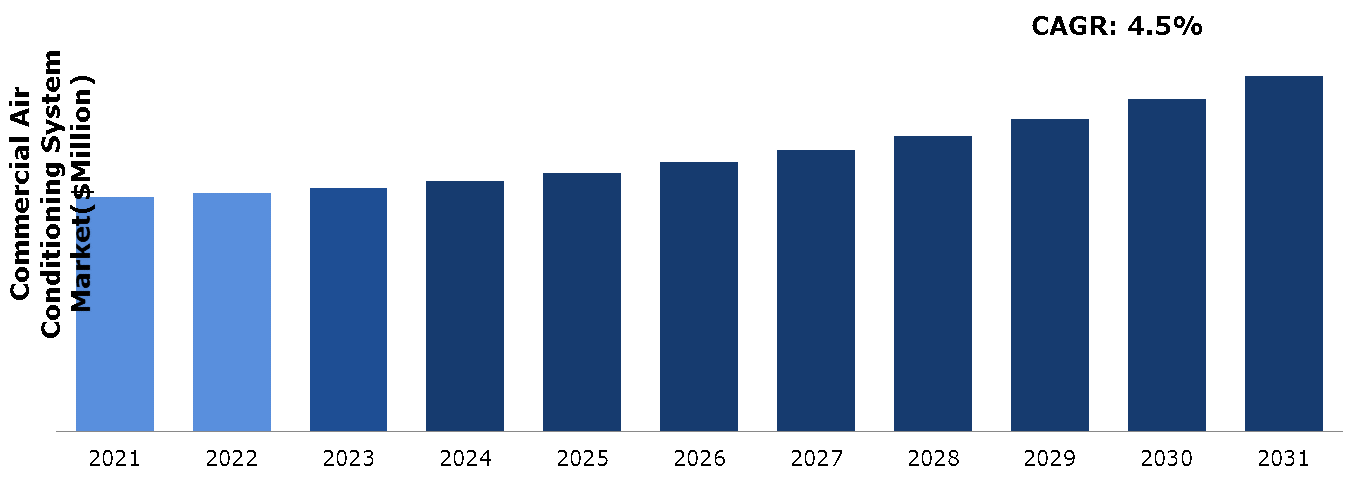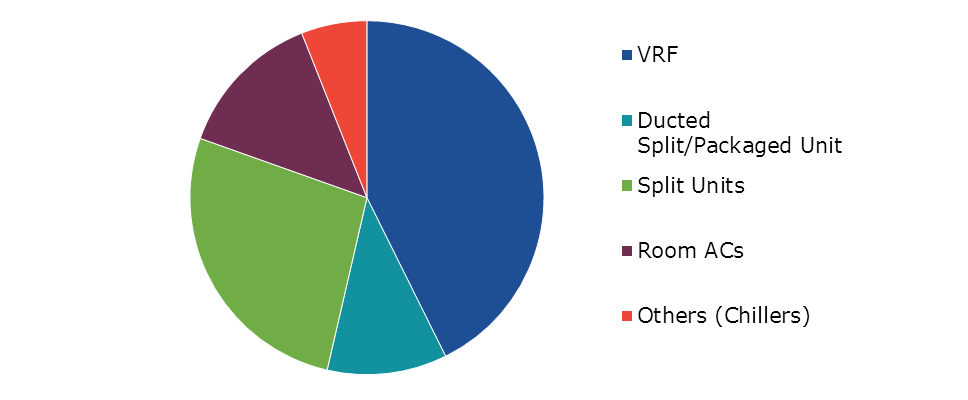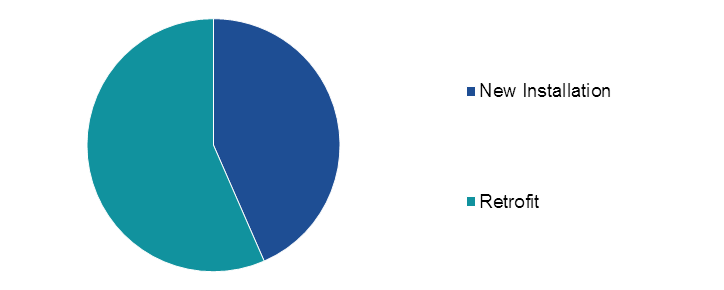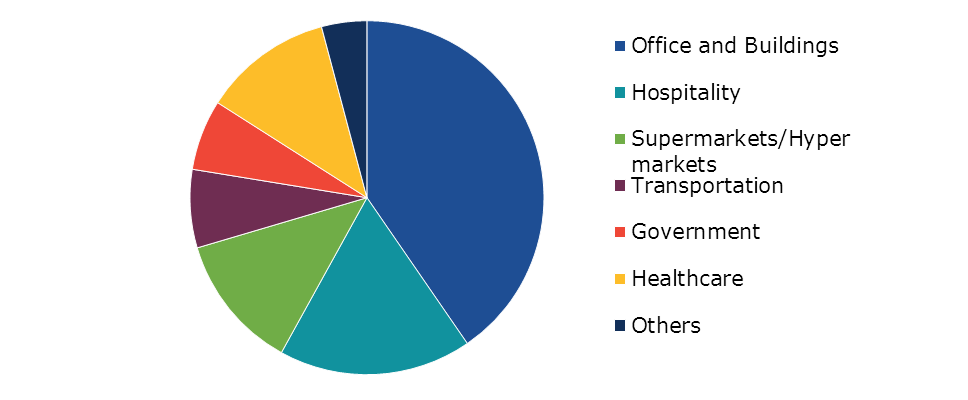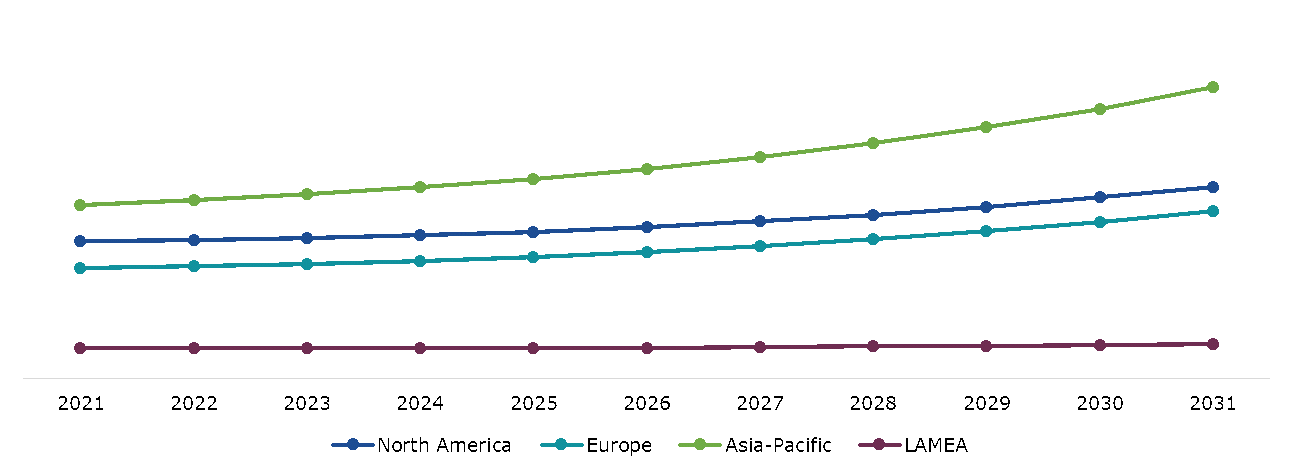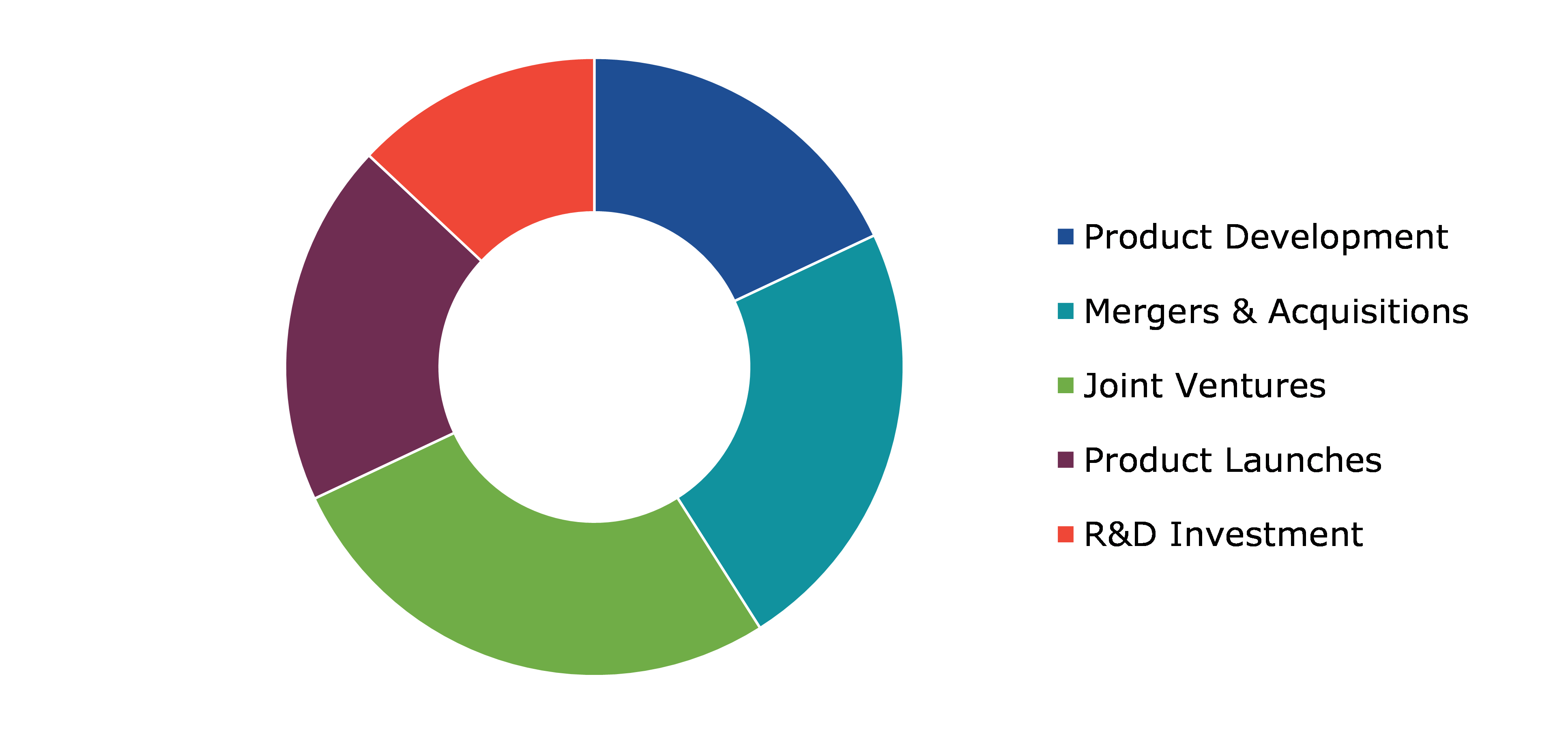Global Commercial Air Conditioning System Market Report
RA08366
Global Commercial Air Conditioning System Market by Type (VRF, Ducted Split/Packaged Unit, Split Units, Room ACs, and Others), Installation Type (New Installation and Retrofit), End User (Office & Buildings, Hospitality, Supermarkets/Hypermarkets, Transportation, Government, Healthcare, and Others) and Region (North America, Europe, Asia-Pacific, and LAMEA): Opportunity Analysis and Industry Forecast, 2022-2031
Global Commercial Air Conditioning System Market Analysis
The Global Commercial Air Conditioning System Market Size was $38,262.10 million in 2021 and is predicted to grow with a CAGR of 4.5%, by generating a revenue of $57,938.30 million by 2031.
Global Commercial Air Conditioning System Market Synopsis
The commercial air conditioning system market is experiencing increasing demand for energy efficient HVAC (Heating, Ventilation, and Air Conditioning) systems due to several factors, including increasing awareness of the impact of greenhouse gas emissions on the environment, rising energy costs, and government regulations that mandate energy efficiency standards for buildings and appliances. Air conditioning is one of the most common ways to control the temperature in offices and other spaces. Many of the latest HVAC systems are designed to be environmentally friendly. Modern systems automatically adjust the temperature to ensure that it’s at a constant level throughout the day. For instance, there are timers that turn the system on and off to maximize efficiency. These factors are anticipated to boost the commercial air conditioning system market demand in the coming years.
Some of the disadvantages of commercial air conditioning systems are the impact to the environment. Also, it is possible to encourage businesses to create air conditioning systems that use less power and produce fewer greenhouse emissions. Businesses should inform clients about the way air conditioning systems affect the environment and encourage the adoption of greener alternatives like evaporation cooling systems or natural ventilation. Governments and regulatory organizations may also pass laws requiring businesses to produce air conditioning systems in accordance with a set of environmental guidelines.
An increasing number of commercial buildings are being constructed, and those that already exist are being refurbished to integrate cutting-edge air conditioning systems, as a consequence of urbanization and the rise in global temperatures. In addition to regulating temperature, air conditioning systems offer building occupants improved indoor air quality and higher comfort, which may boost output and improve health. There is projected to be an increase in demand for commercial building air conditioning systems. As building owners and managers search for methods to save energy expenses and lessen their carbon impact, there is a trend towards energy-efficient air conditioning systems. This gives an opportunity for companies who specialize in the design and installation of energy-efficient air conditioning systems to increase their market share.
According to regional analysis, the Asia-Pacific commercial air conditioning system market analysis accounted for the highest market share in 2021. The world's largest and fastest-growing economies, including China, India, and Japan, which are rapidly urbanizing and industrializing, are found in this region. In order to maintain a comfortable interior atmosphere in offices, retail establishments, and other commercial buildings, there is an increasing need for commercial air conditioning systems.
Commercial Air Conditioning System Overview
A commercial air conditioning system is a mechanical system created to manage and regulate temperature, humidity, and air quality in commercial buildings including offices, retail malls, hospitals, schools, and other public areas. These systems utilize a variety of methods, including ventilation, evaporation, and refrigeration cycles, to cool and dehumidify the air. These are often centralized systems, which means that one system is used to cool the whole building and may contain ducting, thermostats, and other parts to distribute and manage airflow. A business air conditioning system's goals include keeping occupants in a pleasant and healthy indoor environment, enhancing focus and productivity, and preventing heat and humidity-related damage to materials and equipment.
COVID-19 Impact on Global Commercial Air Conditioning System Market
The COVID-19 pandemic had a significant impact on the commercial air conditioning system market. Because many companies, offices, and public spaces were temporarily closed or only partially occupied due to the pandemic, there was a decline in the demand for commercial air conditioning equipment. The need for air conditioning systems that can effectively control and prevent the spread of the virus, however, has increased as shops and public spaces started to reopen.
Many commercial air conditioning system producers have developed and marketed air filtration systems that can successfully eliminate viruses and germs from the air in response to the pandemic. As a result, the need for air filtration systems has increased, particularly in hospitals, airports, and other public spaces. In addition, the pandemic has caused many businesses to adopt new working practices including remote work or hybrid models, which has decreased demand for commercial air conditioning systems in office buildings. However, since more people work from home and spend more time indoors, this has been somewhat countered by a rise in demand for domestic air conditioning systems.
Growing Demand of Construction Industry to Drive the Market Growth
The growth in the construction sector is strongly tied to the demand for commercial air conditioning systems. The need for air conditioning systems rises as more offices, malls, and commercial buildings are constructed. This is due to the requirement for more effective air conditioning systems when new commercial buildings are built to provide residents with a comfortable interior environment. Furthermore, as the building sector expands, there is a rising need for ecologically friendly and energy-efficient air conditioning systems that may lower energy costs and carbon emissions. The increasing demand for commercial air conditioning systems is also influenced by variables including modifications to building standards and regulations, technological advancements, and growing consumer awareness of the significance of indoor air quality. The manufacturers of commercial air conditioning systems are investing in R&D to create more effective and environmentally friendly solutions that can satisfy the changing demands of the market.
To know more about global commercial air conditioning system market drivers, get in touch with our analysts here.
High Installation and Maintenance Costs to Restrain the Market Growth
Commercial air conditioning systems typically are more complex and larger than residential ones, which increases the cost of maintenance and installation, in comparison with conventional air conditioning systems, this system costs 15-20% more but uses 50% less energy. According to research by Washington State University, installing a VRF HVAC system costs approximately USD 18 per square foot supplied, whereas a standard HVAC system may cost consumers around USD 12 and USD 15 per square foot. Energy-efficient systems may cost more right away but over time, by lowering energy costs, they may help businesses save money. A few utility providers also provide refunds and incentives to corporations installing energy-efficient technologies, which is anticipated to hamper the commercial air conditioning system market growth.
Growing Adoption of Smart Technologies to Drive Excellent Opportunities
The adoption of smart technologies in the commercial air conditioning industry presents a significant opportunity for growth and innovation. The Internet of Things (IoT) and automation are revolutionizing the way commercial air conditioning systems operate and are managed. By integrating sensors, controllers, and other smart devices, companies can collect and analyze data in real-time to optimize the performance of commercial air conditioning systems. This can lead to improved energy efficiency, reduced operating costs, and enhanced user comfort. Moreover, the adoption of smart technologies in commercial air conditioning systems can also provide new revenue streams for companies. By offering value-added services such as predictive maintenance, remote monitoring, and energy management, companies can create new business models and increase customer loyalty. The commercial air conditioning market is expected to see significant growth in the adoption of smart technologies in the coming years.
To know more about global commercial air conditioning system market opportunities, get in touch with our analysts here.
Global Commercial Air Conditioning System Market, by Type
Based on type, the market has been divided into VRF, Ducted Split/Packaged Unit, Split Units, Room ACs and others. Among these, the VRF sub-segment accounted for the highest market share in 2021.
Global Commercial Air Conditioning System Market Share, by Type, 2021
Source: Research Dive Analysis
The VRF sub-type accounted for the highest commercial air conditioning system market share in 2021. Due to its energy efficiency, flexible design, and zoning possibilities, variable refrigerant flow (VRF) technology has gained popularity recently. The indoor areas are cooled or heated by a refrigerant using a VRF system, which comprises of an outdoor unit connected to one or more indoor units. Owners of commercial buildings that wish to cut back on energy use and running expenses are drawn to VRF systems because of their reputation for great energy efficiency. With fluctuating occupancy and use patterns in commercial buildings, VRF systems' ability to individually manage temperature in various zones or rooms is very important. Although VRF systems may cost more initially than conventional HVAC systems, building owners can save a lot of money over the long run due to their energy efficiency and zoning capabilities. The market for VRF systems has expanded as a result of government policies and incentives that support green construction and energy efficiency.
Global Commercial Air Conditioning System Market, by Installation Type
Based on installation type, the market has been divided into new installation and retrofit. Among these, the retrofit sub-segment accounted for highest revenue share in 2021.
Global Commercial Air Conditioning System Market Size, by Installation Type, 2021
Source: Research Dive Analysis
The retrofit sub-segment accounted for the highest commercial air conditioning system market share in 2021. Energy-efficient solutions are largely needed for the retrofit portion of the commercial air conditioning system market. Since many commercial structures were constructed before stringent energy regulations were put in place, their HVAC systems might not comply with modern energy efficiency standards. Energy consumption, operational expenses, and indoor air quality may all be improved by retrofitting old systems with contemporary, high-efficiency technology. Furthermore, retrofitting is frequently a less expensive option than completely replacing the current system. Without the expense and inconvenience of removing the old system and installing a new one, it enables building owners to replace their HVAC equipment. These factors are anticipated to boost the growth of retrofit sub-segment during the analysis timeframe.
Global Commercial Air Conditioning System Market, by End User
Based on end user, the market has been divided into office & buildings, hospitality, supermarkets/hypermarkets, transportation, government, healthcare, and others. Among these, the office & buildings sub-segment accounted for highest revenue share in 2021.
Global Commercial Air Conditioning System Market Growth, by End- User, 2021
Source: Research Dive Analysis
The office and buildings sub-segment accounted for the highest market share in 2021. An increasing demand for energy-efficient, cost-effective air conditioning systems that can create a comfortable and healthy interior atmosphere can be seen in the office & buildings segment of the commercial air conditioning system market. The emphasis on energy efficiency, sustainability, and indoor air quality is developing in the construction industry as a result of greater knowledge of the effects of buildings on the environment and human health. The market for commercial air conditioning systems is expanding because of the growing trend of smart buildings and the incorporation of cutting-edge technologies like the Internet of Things (IoT) and artificial intelligence (AI) in HVAC systems. Real-time monitoring and management of interior settings is made possible by smart building technology, which may optimize energy use and save operating costs. These factors are anticipated to boost the growth of office and buildings sub-segments during the commercial air conditioning system market forecast period.
Global Commercial Air Conditioning System Market, Regional Insights
The commercial air conditioning system market was investigated across North America, Europe, Asia-Pacific, and LAMEA.
Global Commercial Air Conditioning System Market Size & Forecast, by Region, 2021-2031 (USD Million)
Source: Research Dive Analysis
The Market for Commercial Air Conditioning System in Asia-Pacific to be the Most Dominant
The Asia-Pacific commercial air conditioning system market size accounted for the highest market share in 2021. The Asia-Pacific region is increasingly urbanizing, contributing to a rise in the construction activity. With a rise in office buildings, shopping centers, and other commercial areas, the commercial sector in the Asia-Pacific region is expanding rapidly. Commercial air conditioning systems are in high demand as a result of this. The demand for commercial air conditioning systems is rising as more individuals choose to install air conditioning systems in their homes and workplaces as a result of rising disposable income in the Asia-Pacific region. Energy-efficient air conditioning systems are in demand as a result of measures being implemented by governments in the Asia-Pacific region to minimize greenhouse gas emissions. Asia-Pacific region manufacturers of commercial air conditioning systems are investing in R&D to create more eco-friendly, energy-efficient systems. This has increased the demand for these systems in the region.
Competitive Scenario in the Global Commercial Air Conditioning System Market
Investment and agreement are common strategies followed by major market players. For instance, in June 2020, Daikin Industries, Ltd. announced the establishment of a joint venture with WASSHA Inc. The joint venture developed a new company, Baridi Inc., to provide air conditioning systems on a subscription basis for the people of the United Republic of Tanzania.
Source: Research Dive Analysis
Some of the leading commercial air conditioning system market players are Carrier.; DAIKIN INDUSTRIES, Ltd; FUJITSU GENERAL; Haier Inc; Hitachi, Ltd.; LG Electronics.; Mitsubishi Electric Corporation; Panasonic Corporation; SAMSUNG; and AIREDALE INTERNATIONAL AIR CONDITIONING LTD.
| Aspect | Particulars |
| Historical Market Estimations | 2020 |
| Base Year for Market Estimation | 2021 |
| Forecast Timeline for Market Projection | 2022-2031 |
| Geographical Scope | North America, Europe, Asia-Pacific, LAMEA |
| Segmentation by Type |
|
| Segmentation by Installation Type |
|
| Segmentation by End-User |
|
| Key Companies Profiled |
|
Q1. What is the size of the global commercial air conditioning system market?
A. The size of the global commercial air conditioning system market was over $38,262.10 million in 2021 and is projected to reach $57,938.30 million by 2031.
Q2. Which are the major companies in the commercial air conditioning system market?
A. Carrier, Daikin Industries, Ltd, and Fujitsu General are some of the key players in the global commercial air conditioning system market.
Q3. Which region, among others, possesses greater investment opportunities in the near future?
A. The Asia-Pacific region possesses great investment opportunities for investors to witness the most promising growth in the future.
Q4. What will be the growth rate of the Asia-Pacific commercial air conditioning system market?
A. Asia-Pacific commercial air conditioning system market is anticipated to grow at 5.6% CAGR during the forecast period.
Q5. What are the strategies opted by the leading players in this market?
A. Agreement and investment are the two key strategies opted by the operating companies in this market.
Q6. Which companies are investing more on R&D practices?
A. Haier Inc, Hitachi Ltd., and LG Electronics are the companies investing more on R&D activities for developing new products and technologies.
1.Research Methodology
1.1.Desk Research
1.2.Real time insights and validation
1.3.Forecast model
1.4.Assumptions and forecast parameters
1.5.Market size estimation
1.5.1.Top-down approach
1.5.2.Bottom-up approach
2.Report Scope
2.1.Market definition
2.2.Key objectives of the study
2.3.Report overview
2.4.Market segmentation
2.5.Overview of the impact of COVID-19 on Global commercial air conditioning system market
3.Executive Summary
4.Market Overview
4.1.Introduction
4.2.Growth impact forces
4.2.1.Drivers
4.2.2.Restraints
4.2.3.Opportunities
4.3.Market value chain analysis
4.3.1.List of raw material suppliers
4.3.2.List of manufacturers
4.3.3.List of distributors
4.4.Innovation & sustainability matrices
4.4.1.Technology matrix
4.4.2.Regulatory matrix
4.5.Porter’s five forces analysis
4.5.1.Bargaining power of suppliers
4.5.2.Bargaining power of consumers
4.5.3.Threat of substitutes
4.5.4.Threat of new entrants
4.5.5.Competitive rivalry intensity
4.6.PESTLE analysis
4.6.1.Political
4.6.2.Economical
4.6.3.Social
4.6.4.Technological
4.6.5.Environmental
4.7.Impact of COVID-19 on commercial air conditioning system market
4.7.1.Pre-covid market scenario
4.7.2.Post-covid market scenario
5.Commercial Air Conditioning System Market Analysis, by Type
5.1.Overview
5.2.VRF
5.2.1.Definition, key trends, growth factors, and opportunities
5.2.1.1.Market size analysis, by region,2021-2031
5.2.1.2.Market share analysis, by country,2021-2031
5.3.Ducted Split/Packaged Unit
5.3.1.Definition, key trends, growth factors, and opportunities
5.3.1.1.Market size analysis, by region,2021-2031
5.3.1.2.Market share analysis, by country,2021-2031
5.4.Split Units
5.4.1.Definition, key trends, growth factors, and opportunities
5.4.1.1.Market size analysis, by region,2021-2031
5.4.1.2.Market share analysis, by country,2021-2031
5.5.Room ACs
5.5.1.Definition, key trends, growth factors, and opportunities
5.5.1.1.Market size analysis, by region,2021-2031
5.5.1.2.Market share analysis, by country,2021-2031
5.6.Others
5.6.1.Definition, key trends, growth factors, and opportunities
5.6.1.1.Market size analysis, by region,2021-2031
5.6.1.2.Market share analysis, by country,2021-2031
5.7.Research Dive Exclusive Insights
5.7.1.Market attractiveness
5.7.2.Competition heatmap
6.Commercial Air Conditioning System Market Analysis, by Installation Type
6.1.New Installation
6.1.1.Definition, key trends, growth factors, and opportunities
6.1.1.1.Market size analysis, by region,2021-2031
6.1.1.2.Market share analysis, by country,2021-2031
6.2.Retrofit
6.2.1.Definition, key trends, growth factors, and opportunities
6.2.1.1.Market size analysis, by region,2021-2031
6.2.1.2.Market share analysis, by country,2021-2031
6.3.Research Dive Exclusive Insights
6.3.1.Market attractiveness
6.3.2.Competition heatmap
7.Commercial Air Conditioning System Market Analysis, by End-User
7.1.Office and Buildings
7.1.1.Definition, key trends, growth factors, and opportunities
7.1.1.1.Market size analysis, by region,2021-2031
7.1.1.2.Market share analysis, by country,2021-2031
7.2.Hospitality
7.2.1.Definition, key trends, growth factors, and opportunities
7.2.1.1.Market size analysis, by region,2021-2031
7.2.1.2.Market share analysis, by country,2021-2031
7.3.Supermarkets/Hypermarkets
7.3.1.Definition, key trends, growth factors, and opportunities
7.3.1.1.Market size analysis, by region,2021-2031
7.3.1.2.Market share analysis, by country,2021-2031
7.4.Transportation
7.4.1.Definition, key trends, growth factors, and opportunities
7.4.1.1.Market size analysis, by region,2021-2031
7.4.1.2.Market share analysis, by country,2021-2031
7.5.Government
7.5.1.Definition, key trends, growth factors, and opportunities
7.5.1.1.Market size analysis, by region,2021-2031
7.5.1.2.Market share analysis, by country,2021-2031
7.6.Healthcare
7.6.1.Definition, key trends, growth factors, and opportunities
7.6.1.1.Market size analysis, by region,2021-2031
7.6.1.2.Market share analysis, by country,2021-2031
7.7.Others
7.7.1.Definition, key trends, growth factors, and opportunities
7.7.1.1.Market size analysis, by region,2021-2031
7.7.1.2.Market share analysis, by country,2021-2031
7.8.Research Dive Exclusive Insights
7.8.1.Market attractiveness
7.8.2.Competition heatmap
8.Commercial Air Conditioning System Market, by Region
8.1.North America
8.1.1.U.S.
8.1.1.1.Market size analysis, by Type,2021-2031
8.1.1.2.Market size analysis, by Installation Type,2021-2031
8.1.1.3.Market size analysis, by End-user,2021-2031
8.1.2.Canada
8.1.2.1.Market size analysis, by Type,2021-2031
8.1.2.2.Market size analysis, by Installation Type,2021-2031
8.1.2.3.Market size analysis, by End-user,2021-2031
8.1.3.Mexico
8.1.3.1.Market size analysis, by Type,2021-2031
8.1.3.2.Market size analysis, by Installation Type,2021-2031
8.1.3.3.Market size analysis, by End-user,2021-2031
8.1.4.Research Dive Exclusive Insights
8.1.4.1.Market attractiveness
8.1.4.2.Competition heatmap
8.2.Europe
8.2.1.Germany
8.2.1.1.Market size analysis, by Type,2021-2031
8.2.1.2.Market size analysis, by Installation Type,2021-2031
8.2.1.3.Market size analysis, by End-user,2021-2031
8.2.2.UK
8.2.2.1.Market size analysis, by Type,2021-2031
8.2.2.2.Market size analysis, by Installation Type,2021-2031
8.2.2.3.Market size analysis, by End-user,2021-2031
8.2.3.France
8.2.3.1.Market size analysis, by Type,2021-2031
8.2.3.2.Market size analysis, by Installation Type,2021-2031
8.2.3.3.Market size analysis, by End-user,2021-2031
8.2.4.Spain
8.2.4.1.Market size analysis, by Type,2021-2031
8.2.4.2.Market size analysis, by Installation Type,2021-2031
8.2.4.3.Market size analysis, by End-user,2021-2031
8.2.5.Italy
8.2.5.1.Market size analysis, by Type,2021-2031
8.2.5.2.Market size analysis, by Installation Type,2021-2031
8.2.5.3.Market size analysis, by End-user,2021-2031
8.2.6.Rest of Europe
8.2.6.1.Market size analysis, by Type,2021-2031
8.2.6.2.Market size analysis, by Installation Type,2021-2031
8.2.6.3.Market size analysis, by End-user,2021-2031
8.2.7.Research Dive Exclusive Insights
8.2.7.1.Market attractiveness
8.2.7.2.Competition heatmap
8.3.Asia Pacific
8.3.1.China
8.3.1.1.Market size analysis, by Type,2021-2031
8.3.1.2.Market size analysis, by Installation Type,2021-2031
8.3.1.3.Market size analysis, by End-user,2021-2031
8.3.2.Japan
8.3.2.1.Market size analysis, by Type,2021-2031
8.3.2.2.Market size analysis, by Installation Type,2021-2031
8.3.2.3.Market size analysis, by End-user,2021-2031
8.3.3.India
8.3.3.1.Market size analysis, by Type,2021-2031
8.3.3.2.Market size analysis, by Installation Type,2021-2031
8.3.3.3.Market size analysis, by End-user,2021-2031
8.3.4.Australia
8.3.4.1.Market size analysis, by Type,2021-2031
8.3.4.2.Market size analysis, by Installation Type,2021-2031
8.3.4.3.Market size analysis, by End-user,2021-2031
8.3.5.South Korea
8.3.5.1.Market size analysis, by Type,2021-2031
8.3.5.2.Market size analysis, by Installation Type,2021-2031
8.3.5.3.Market size analysis, by End-user,2021-2031
8.3.6.Rest of Asia Pacific
8.3.6.1.Market size analysis, by Type,2021-2031
8.3.6.2.Market size analysis, by Installation Type,2021-2031
8.3.6.3.Market size analysis, by End-user,2021-2031
8.3.7.Research Dive Exclusive Insights
8.3.7.1.Market attractiveness
8.3.7.2.Competition heatmap
8.4.LAMEA
8.4.1.Brazil
8.4.1.1.Market size analysis, by Type,2021-2031
8.4.1.2.Market size analysis, by Installation Type,2021-2031
8.4.1.3.Market size analysis, by End-user,2021-2031
8.4.2.Saudi Arabia
8.4.2.1.Market size analysis, by Type,2021-2031
8.4.2.2.Market size analysis, by Installation Type,2021-2031
8.4.2.3.Market size analysis, by End-user,2021-2031
8.4.3.UAE
8.4.3.1.Market size analysis, by Type,2021-2031
8.4.3.2.Market size analysis, by Installation Type,2021-2031
8.4.3.3.Market size analysis, by End-user,2021-2031
8.4.4.South Africa
8.4.4.1.Market size analysis, by Type,2021-2031
8.4.4.2.Market size analysis, by Installation Type,2021-2031
8.4.4.3.Market size analysis, by End-user,2021-2031
8.4.5.Rest of LAMEA
8.4.5.1.Market size analysis, by Type,2021-2031
8.4.5.2.Market size analysis, by Installation Type,2021-2031
8.4.5.3.Market size analysis, by End-user,2021-2031
8.4.6.Research Dive Exclusive Insights
8.4.6.1.Market attractiveness
8.4.6.2.Competition heatmap
9.Competitive Landscape
9.1.Top winning strategies, 2021
9.1.1.By strategy
9.1.2.By year
9.2.Strategic overview
9.3.Market share analysis, 2021
10.Company Profiles
10.1.Carrier
10.1.1.Overview
10.1.2.Business segments
10.1.3.Product portfolio
10.1.4.Financial performance
10.1.5.Recent developments
10.1.6.SWOT analysis
10.2.Daikin Industries, Ltd
10.2.1.Overview
10.2.2.Business segments
10.2.3.Product portfolio
10.2.4.Financial performance
10.2.5.Recent developments
10.2.6.SWOT analysis
10.3.Fujitsu General
10.3.1.Overview
10.3.2.Business segments
10.3.3.Product portfolio
10.3.4.Financial performance
10.3.5.Recent developments
10.3.6.SWOT analysis
10.4.Haier Inc.
10.4.1.Overview
10.4.2.Business segments
10.4.3.Product portfolio
10.4.4.Financial performance
10.4.5.Recent developments
10.4.6.SWOT analysis
10.5.Hitachi
10.5.1.Overview
10.5.2.Business segments
10.5.3.Product portfolio
10.5.4.Financial performance
10.5.5.Recent developments
10.5.6.SWOT analysis
10.6.LG Electronics.
10.6.1.Overview
10.6.2.Business segments
10.6.3.Product portfolio
10.6.4.Financial performance
10.6.5.Recent developments
10.6.6.SWOT analysis
10.7.Mitsubishi Electric Corporation
10.7.1.Overview
10.7.2.Business segments
10.7.3.Product portfolio
10.7.4.Financial performance
10.7.5.Recent developments
10.7.6.SWOT analysis
10.8.Panasonic Corporation
10.8.1.Overview
10.8.2.Business segments
10.8.3.Product portfolio
10.8.4.Financial performance
10.8.5.Recent developments
10.8.6.SWOT analysis
10.9.Samsung
10.9.1.Overview
10.9.2.Business segments
10.9.3.Product portfolio
10.9.4.Financial performance
10.9.5.Recent developments
10.9.6.SWOT analysis
10.10.Airedale International Air Conditioning Ltd.
10.10.1.Overview
10.10.2.Business segments
10.10.3.Product portfolio
10.10.4.Financial performance
10.10.5.Recent developments
10.10.6.SWOT analysis
VRF (Variable Refrigerant Flow) functions at varying speeds that reduce energy load and saves approximately 55% of energy as compared to the traditional HVAC (Heating, Ventilation, and Air Conditioning) systems. The commercial air conditioning systems (VRF) includes an air conditioner inverter and as per comfort alters refrigerant flow and motor speed. These systems are popular commercially because they offer climate control by the building’s occupants. Moreover, the VRF systems can simultaneously alter temperatures in various rooms within a building. Also, VRF systems run automatically, and only the main control panel needs to set at an ideal room temperature. Minimal ductwork, delivery of constant comfort, and quiet operations are some of the benefits of using the VRF systems in a commercial building.
Forecast Analysis of the Commercial Air Conditioning Systems (VRF) Market
The global commercial air conditioning system (VRF) market is predicted to enhance in the upcoming years due to its energy-efficient nature. The conventional HVAC systems take up almost 50% of the total energy, thus burdening the consumer financially. As a result, people are shifting towards the VRF systems as they are energy efficient, easy to install, and quieter. Furthermore, awareness about energy efficiency is rising, and this has led to the adoption of VRF systems in countries such as Japan, the U.S.A, and China. For instance, an article on the economic times site stated that the 14th five-year-plan has been approved by the National People’s Congress, China. The nation has outlined climate and energy policies for the upcoming decade. China is set to work on plans for peaking carbon emissions before 2030 and achieve carbon neutrality by the end of 2060. Apart from this, an article stated that Japan observes ‘Energy conservation Day’ on the first day of every month and ‘Energy Conservation Month’ in February every year. These all factors are expected to boost the market growth in the forthcoming years.
According to a report published by Research Dive, the global commercial air conditioning system (VRF) market is anticipated to reach $34,619.00 million from 2020 to 2027 timeframe. Furthermore, several studies state that the performance of the VRF systems is more efficient than the conventional HVAC systems such as rooftop variable air volume systems (RTU-VAV) and boiler systems. For instance, an article on sciencedirect.com states that the VRF systems save approximately 15% to 42% and 18% to 33% for HVAC and source energy usage respectively as compared to the RTU-VAV systems. Apart from this, the VRF systems offer better cooling capacity in a multistorey building. These all factors are expected to influence the market growth in the future years.
Recent Developments in the Market
The well-known players of the global commercial air conditioning systems (VRF) market are aiming for unique strategies such as building product portfolios, mergers and acquisitions of promising companies, investments in research & development areas, new product announcements, and financing for the forthcoming activities and innovations. These tactics are propelling the growth of businesses across the world. For instance, in January 2021, Samsung, a multinational conglomerate company based in South Korea, announced the launch of large-capacity VRF air conditioning systems in India. This system can be installed in 0.5 square meters of space in villas, premium apartments, houses, and bungalows. This VRF system offers eco-friendly, efficient, and quiet air conditioning as well.
Apart from this, in January 2019, Trane, a manufacturing company of ventilation, heating, and air conditioning, introduced Genyue5+, a full DC inverter VRF system for SAARC and Indian markets. This product is an ideal choice for healthcare, retail, hospitality, educational facilities, and commercial sectors. Moreover, in July 2017, Mitsubishi India, an automotive company, introduced a new range of VRF (Variable Refrigerant Flow) air conditioning systems. The product's design is in-built for operation, smart control, and compactness of the system.
Covid-19 Impact on the Market
The global commercial air conditioning systems (VRF) market experienced a significant impact due to the Covid-19 pandemic. The reason being disruptions in the supply chains of the industries and social distancing protocols due to which installation services declined, thus resulting in reduced demand of the VRF systems. Furthermore, the implementation of safety protocols brought down the manpower in the industries, thus decreasing the production rate as well. These all aspects are affecting the global market during the coronavirus pandemic.
Future Scope of the Market
The demand for air conditioning systems is estimated to rise in countries such as India, UAE, Brazil, and Mexico due to an increase in disposable income and a rise in temperature levels. The desire for luxurious items by households is likely to create opportunities for the market in the upcoming years.
Personalize this research
- Triangulate with your own data
- Request your format and definition
- Get a deeper dive on a specific application, geography, customer or competitor
- + 1-888-961-4454 Toll - Free
- support@researchdive.com

